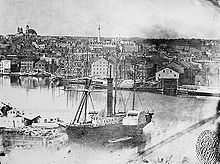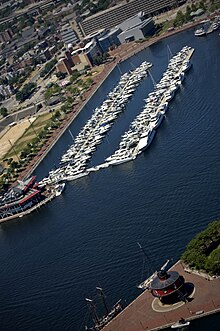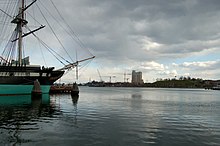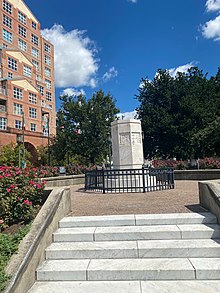Neighborhood in Baltimore, Maryland, United States
| Inner Harbor | |
|---|---|
| Neighborhood | |
 The Inner Harbor in Baltimore in August 2020 The Inner Harbor in Baltimore in August 2020 | |
  | |
| Coordinates: 39°17′01″N 76°36′36″W / 39.283494°N 76.609897°W / 39.283494; -76.609897 | |
| Country | United States |
| State | Maryland |
| City | Baltimore |
| Population | 1,839 |
The Inner Harbor is a historic seaport, tourist attraction, and landmark in Baltimore, Maryland. It was described by the Urban Land Institute in 2009 as "the model for post-industrial waterfront redevelopment around the world". The Inner Harbor is located at the mouth of Jones Falls, creating the wide and short northwest branch of the Patapsco River. The district includes any water west of a line drawn between the foot of President Street and the American Visionary Art Museum.
The name "Inner Harbor" is used not just for the water but for the surrounding area of the city, with approximate street boundaries of President Street to the east, Lombard Street to the north, Greene Street to the west, and Key Highway on the south. The harbor is within walking distance of Oriole Park at Camden Yards and M&T Bank Stadium. A water taxi connects passengers to Fells Point, Canton, and Fort McHenry.
History
| This section needs additional citations for verification. Please help improve this article by adding citations to reliable sources in this section. Unsourced material may be challenged and removed. Find sources: "Inner Harbor" – news · newspapers · books · scholar · JSTOR (October 2022) (Learn how and when to remove this message) |


While Baltimore has been a major U.S. seaport since the 18th century, the historically shallow water of the Inner Harbor prior to its manipulation through dredging was not conducive to large ships or heavy industry. These were concentrated in Locust Point, Fell's Point, and Canton.
In the mid-20th century, Baltimore suffered from the economic decline of restructuring common to many industrial cities in the United States. Old harbors were abandoned with the arrival of container ships after World War II. Later, the old harbors were adapted as focal points to reconnect cities with their waterfronts, and develop public spaces, tourism, business, and housing.
During the 1940s, John H. Threadgill, the head of the Steamship Trade Association, initiated a study for a cross-harbor bridge. A bridge across the Inner Harbor of Baltimore was one idea that was discussed frequently. In his capacity as head of the association, Threadgill ultimately recommended that the idea for a cross-harbor bridge be abandoned, due to the fact that Baltimore relied heavily on a shipping trade and fears that the bridge would negatively impede the flow of shipping traffic at the Port of Baltimore. Threadgill was named head of Baltimore's Port Commission during the 1950s.
In the 1950s, economic changes ended both the freight and passenger use of the Inner Harbor, such as the Old Bay Line's steamers. Rotting warehouses and piers were eventually torn down and replaced by open, grass-covered parkland that was used for recreational purposes and occasional large events.
The waterfront was gradually transformed with award-winning parks and plazas surrounded by office buildings, hotels and leisure attractions, which reversed the city's decline and became a model for urban renaissance in cities around the world. The renewal of Baltimore's Inner Harbor area began with the adoption of the 33-acre (13 ha) Charles Center project by the City Council and Mayor Thomas D'Alesandro in March 1958. Between 1958 and 1965, Baltimore renewed the center of its business district by rebuilding Charles Center with office buildings, hotels, and retail shops.
At the beginning of mayor Theodore R. McKeldin's second term in 1963, the redevelopment program was expanded to include 240 acres (97 ha) surrounding the Inner Harbor. Corporate headquarters and hotels were built around the shoreline of the Inner Harbor. A public park and promenade were added for leisure activity and community gatherings.
On July 4, 1976, following the rendezvous of Tall Ships in New York for the U.S. Bicentennial, eight ships from other nations visited Baltimore, where they attracted a huge number of tourists. This interest helped spur the development of other tourist attractions – including the National Aquarium, Maryland Science Center, and the Harborplace festival marketplace (operated by The Rouse Company), which opened on July 4, 1980. The nearby Baltimore Convention Center and Hyatt Regency Baltimore Hotel added to the services and resulted in population density and visitors.
With the success of the Inner Harbor in the 1970s and 1980s, Baltimore became a worldwide tourist destination and model of urban planning and development. It influenced more than 100 other cities and won more than 40 national or international awards, including a citation by the American Institute of Architects in 1984 as "one of the supreme achievements of large-scale urban design and development in U.S. history".
In recent years, the area along the waterfront to the east of the Inner Harbor (in the direction of Fells Point and Little Italy) has been developed with condominiums, retail space, restaurants, and hotels – an ongoing project known as Harbor East.
While little development land remains around the Inner Harbor, the available land has been subject to many plans, which have not been realized. Recently completed projects include mixed-use developments incorporating office space, street-level retail, and condominiums, as well as hotel projects such as the Ritz Carlton Residences, a condominium project on Key Highway at the southeast corner of the Inner Harbor.
In September 2003, the Inner Harbor area was flooded by Hurricane Isabel. The Baltimore World Trade Center remained closed for a month, but all the other buildings were saved from flooding by the Inner Harbor development controls, which were created by the master developer team of Charles Center-Inner Harbor Management, Inc.
In March 2004, a water taxi capsized during a storm on the Northwest Branch of the Patapsco River near Fort McHenry. While occurring over a mile downstream of the Inner Harbor, the accident was associated with the Inner Harbor by news reports and casual observers. Five passengers died in the accident, which the National Transportation Safety Board determined was caused when the small pontoon-style vessel encountered unpredictable strong winds and waves.
 Baltimore's Inner Harbor at sunset in 2017 (panorama scrolls left and right)
Baltimore's Inner Harbor at sunset in 2017 (panorama scrolls left and right)
Attractions

Museums
- American Visionary Art Museum
- Baltimore Public Works Museum (opened 1982; closed 2010)
- Baltimore Museum of Industry
- Civil War Museum at President Street Station
- Geppi's Entertainment Museum (opened 2006; closed 2018)
- Jewish Museum of Maryland at Lloyd Street Synagogue
- Maryland Science Center
- National Museum of Dentistry
- Port Discovery Children's Museum on the site of the historic Baltimore fish market
- Reginald F. Lewis Museum of Maryland African American History & Culture
- Ripley's Believe It or Not! Odditorium (opened 2012; closed 2020)
- Sports Legends Museum at Camden Yards (opened 2005; closed 2015)
Ships

- Historic Ships in Baltimore:
- US Coast Guard Cutter WHEC-37 – last fighting ship still afloat that survived the attack on Pearl Harbor
- USS Torsk – Tench-class submarine; last ship to sink enemy vessel in World War II
- Lightship Chesapeake
- Seven Foot Knoll Lighthouse
- USS Constellation – only Civil War-era ship still afloat
- Vessels on active/reserve status:
- SS Wright – US Navy Aviation Logistics Support (roll-on/roll-off) container ship
- Former vessels
- USNS Comfort – US Navy hospital ship (in Baltimore through March 2013)
Entertainment venues

Sports
- Babe Ruth Birthplace and Museum
- Baltimore Grand Prix, a street race for Indycar and American Le Mans Series
- Camden Yards Sports Complex
- M&T Bank Stadium, home of the Baltimore Ravens
- Oriole Park at Camden Yards, home of the Baltimore Orioles
- Sports Legends Museum at Camden Yards (closed 2015)
Concert halls and arenas
- Baltimore Convention Center
- CFG Bank Arena (formerly known by various other names)
- Pier Six Pavilion
- Power Plant Live!, a collection of bars and clubs that includes Rams Head Live!
Notable architecture
- National Katyń Memorial
- Bnai Israel – an active Moorish Revival synagogue
The Lloyd Street Synagogue, just up the street, is a museum. Between the two synagogue buildings is the Jewish Museum of Maryland.
Other attractions

- National Aquarium in Baltimore
- Harborplace and the Gallery
- Maryland Science Center
- The Pratt Street Power Plant (containing Hard Rock Cafe and other restaurants, and formerly the original ESPN Zone, which closed in June 2010.)
- Top of the World at the Baltimore World Trade Center
- Holocaust Memorial
- Columbus Center, home of the University of Maryland Biotechnology Institute
- Lockwood Place
- Baltimore Visitor Center
- Lloyd Street Synagogue, the third-oldest synagogue in the United States, now a museum
- McKeldin Square
Free speech

As a central and busy part of Baltimore, the Inner Harbor has been the site of much political and artistic activity. The city is involved in ongoing disputes over free speech in the area. One early conflict concerned marchers for gay rights, whose permit was revoked by the city. (The city announced that only five or fewer people could march, and that they could not carry signs.)
The Rouse Company, which began operating Harborplace in 1980, has long been in conflict with street performers. The company regulates performances, and has often been accused of suppressing free speech. These disputes came to a head in 2002–2003, when two events triggered a lawsuit against the city.
ACLU lawsuit
On October 21, 2002, street performer Jerry Rowan was banned from the area for making an "insensitive" joke. Discussing the then-current D.C. sniper case, Rowan said: "I was driving downtown this morning, and on the radio I heard that they've finally come out with a composite of the sniper, so there should be an arrest forthcoming. Apparently, he's a white guy that speaks Spanish and looks like he's Arab." Police officers overheard the joke and reported it to Rouse. The company had previously sent a letter to Rowan admonishing him for "off-color humor", as well as "lack of respect for program administrators". After this report, the company banned him from the area.
On April 4, 2003, a police officer asked Baltimore's Women in Black to disband. The group had (and has) gathered in McKeldin Square every Friday since September 11, 2002.
Rowan and the Women in Black filed suit against the city of Baltimore on October 7, 2003, arguing their right of free speech. They were assisted by attorney Rajeev Goyle on behalf of the American Civil Liberties Union.
The lawsuit was resolved in 2013 in a settlement that resulted in a consent decree with the city, creating "instant permits" for spontaneous demonstrations and waived permit requirements for groups of 30 people or less. The negotiations with the ACLU, the city, The Rouse Company, and The Waterfront Partnership in the settlement yielded other specific results in favor of free speech activities. McKeldin Square, Rash Field, Kaufman Pavilion, the area West of the Visitor Center, and Area 10 were all designated as official free-speech zones. Additionally, the settlement required the City of Baltimore to pay the attorney's fees for the ACLU.
Elsewhere, police enforce rules against protest. On May 21, 2011, teacher Bruce Friedrich was threatened with arrest while handing out animal rights pamphlets. On September 18, 2011, police arrested artist Mark Chase for selling his paintings "in or near" the Inner Harbor amphitheater. "Your constitutional rights have nothing to do with the law," said the arresting officer when Chase objected on First Amendment grounds.
References
- "Overview of Inner Harbor, Baltimore, Maryland (Neighborhood)". Statistical Atlas. Retrieved April 30, 2021.
- "Announcement of 2009 ULI Awards for Excellence." Urban Land Institute, Atlanta, April 24, 2009.
- Ann Breen and Dick Rigby, "Waterfronts: Cities Reclaim Their Edge," The Waterfront Center, McGraw-Hill, 1994, pp. 20–23.
- "Dinner To Boom Trade With Baltimore Held By Cincinnati Groups". The Sun. Baltimore. February 25, 1938. p. 9. ProQuest 543162584.
- Report to Honorable Theodore R. McKeldin on the proposed Cross harbor bridge. 1944. Baltimore, Md.: Steamship Trade Association of Baltimore.
- "Shipping Group Elects Agent: U.S. Lines Officer Named to Port Commission". The Sun. Baltimore. July 3, 1951. p. 13. ProQuest 539009298.
- Jenni Hewett, "Here's a Man-Made Waterfront Aristotle would have liked," Morning Herald, Sydney, Australia, October 27, 1983, p. 12.
- Martin L. Millspaugh, "Critical Mass," Evening Sun, Baltimore, July 1, 1980, p. A11.
- American Institute of Architects, press release, Washington, D.C., Feb 5, 1984.
- "Insufficient Stability Caused Passenger Vessel to Capsize". MarineLink.com. Archived from the original on September 28, 2007. Retrieved July 26, 2007.
- "Overview". Baltimore Marine Centers. Archived from the original on December 20, 2016. Retrieved December 13, 2016.
- Gunther, Katie (September 21, 1984). "City rescinds gay-rights march permit at harbor". Baltimore Sun. Proquest. ProQuest 536612295.
- ^ Ditkoff, Anna (November 6, 2002). "Send Out the Clowns". Baltimore CityPaper. Retrieved July 13, 2012.
- ^ Wilson, Kimberly A.C. (October 8, 2003). "First Amendment lawsuit against the city expanded". Baltimore Sun. Retrieved July 18, 2012.
- "Free Speech Rights Significantly Expanded in Baltimore's Inner Harbor". American Civil Liberties Union. Retrieved May 10, 2022.
- Hermann, Peter (May 27, 2011). "Baltimore police tell teacher to stop leafleting at Inner Harbor". Baltimore Sun. Retrieved July 18, 2012.
- Hermann, Peter (September 19, 2012). "Arrest at Inner Harbor renews free speech debate". Baltimore Sun. Retrieved July 18, 2012.
External links
- Historic American Engineering Record (HAER) No. MD-86, "Baltimore Inner Harbor, Northwest branch of Patapsco River south of Pratt Street & between Light Street & Jones Falls, Baltimore, Independent City, MD", 1 photo, 16 data pages, 1 photo caption page
- HAER No. MD-86-A, "Baltimore Inner Harbor, Pier 5, South of Pratt Street between Market Place & Concord Street", 17 photos, 16 data pages, 3 photo caption pages
- HAER No. MD-86-B, "Baltimore Inner Harbor, Pier 6, South of Pratt Street between Concord Street & Jones Falls outlet", 10 photos, 10 data pages, 3 photo caption pages
- HAER No. MD-86-C, "Baltimore Inner Harbor, Pier 4, South side of Pratt Street between Frederick Street & Market Place", 7 photos, 14 data pages, 2 photo caption pages
| Places adjacent to Inner Harbor | ||||||||||||||||
|---|---|---|---|---|---|---|---|---|---|---|---|---|---|---|---|---|
| ||||||||||||||||